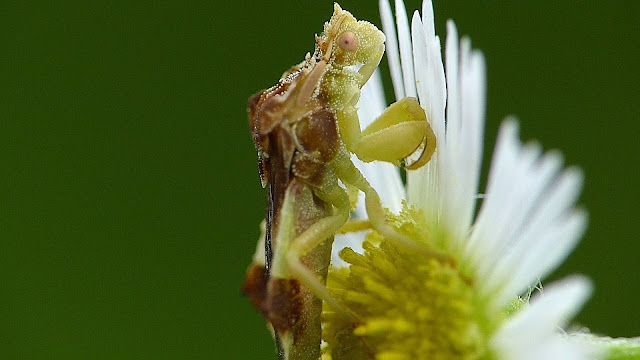 |
| Goldenrod- beauty, danger, and excitement lurk here. |
A few days ago, while on a short walk, we came upon a patch of goldenrod, brilliant yellow and shining like the sun.
Despite broiling in the searing sun of this miserably humid Sunday, I couldn't resist spending some time examining the few newly popped flowers of goldenrod waving in a very gentle breeze. It became clear that the sun played an important role in the plant's life... the only spots where any goldenrod was already flowering were in full sun. I tried to find some in shadier sites where I could be a bit (no, a lot) cooler, but no luck.
The reason I wanted to check the flowers was that I recalled past times when there were Ambush bugs to be found in them.
What are Ambush bugs? They're diminutive insects (about 3/8" long) in the Phymatinae family, but not to be taken lightly if you're an insect up to the size of a small bee. Their modus operandi is to lie patiently amongst the tiny blooms of goldenrod flower heads, and others, in the hope that prey will blunder into them, much to the peril of the unsuspecting.
 |
| Meet the Ambush Bug |
A few minutes into the quest, the fluttering of a flutterby, er, butterfly, caught my eye. It was a dainty little orange Pearly Crescentspot, alighting on a Colgate-white daisy fleabane.
 |
| Pearly Crescentspot on fleabane |
Then I spotted another one clinging to the underside of a nearby fleabane; but it was moving strangely. Its wings were folded, and it didn't appear to be moving under its own power somehow. And I wondered why it was under the flowerhead, when any nectar to be had would be on the top.
Suddenly, a yellow jacket zoomed in and started attacking the butterfly! It darted in and backed off repeatedly, seeming to bite at the Pearly's wings. And the butterfly offered no resistance whatsoever, nor did it fly away. What in the world is going on here?!
 |
| Butterfly held by Ambush bug. Note 2nd Ambush bug at left |
 |
| Bee attacking butterfly held by Ambush bug |
 |
| Bee shreds butterfly |
 |
| Prey being sucked dry. Notice yellow beak. |
 |
| Beak probing body joints |
I watched the two Ambush bugs for a while. The next potential meal arrived in the form of a soldier beetle (I think). It was frantically sniffing around, oblivious to its surroundings, and got within striking distance of one of the predators. It was grabbed by the head. With a brief struggle, it was able to free itself, and wasted no time beating a hasty retreat.
 |
| Soldier beetle in headlock |
Next, a bee (or possibly a bee-like fly) made a landing on the flower. Bingo! A goner.
 |
| Another victim |
The goldenrod flowers were loaded with tiny black Shining Flower beetles (Olibrus), not much larger than a pinhead. I watched an Ambush bug size up one of these beetles, and almost grab it; but it didn't follow through, possibly because it would have been difficult to hold the thing. Just a guess.
 |
| Sizing up an Olibrus beetle |
After a few failed attempts at grabbing its next prey insect, one of the Ambush bugs backed itself down between the little individual flowers of the goldenrod spike, very effectively camoflaging itself. With coloration that blends right in with the flower, it apparently works well. You have to look very closely to spot one in this position. I've read that these predators, with more time spent on a flower, gradually change color to more closely match their flower surroundings. See the photo of the Ambush bug in its hide.
 |
| Ambush bug in ambush hide |
So, this was a pretty exciting day. It started out as a first trial of a new closeup lens, and that paid off nicely in an afternoon of small-scale intrigue.
If you'd like to have a similar adventure, I'd suggest bringing a magnifying glass out to the meadow where goldenrod shines like the sun. You're almost guaranteed to find Ambush bugs, but you'll have to look closely to spot them if you're not already familiar with them. Uh, just don't put your tender nose too close! Hee hee.
If you'd like to see the video of this story, you can watch it at our Youtube channel titled "New England Forests", or click on the video below.
 |
| Pssst -- come a little closer, can't quite see ya. |
No comments:
Post a Comment
Comments are moderated and may not be posted immediately.